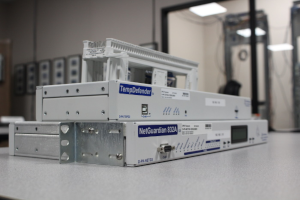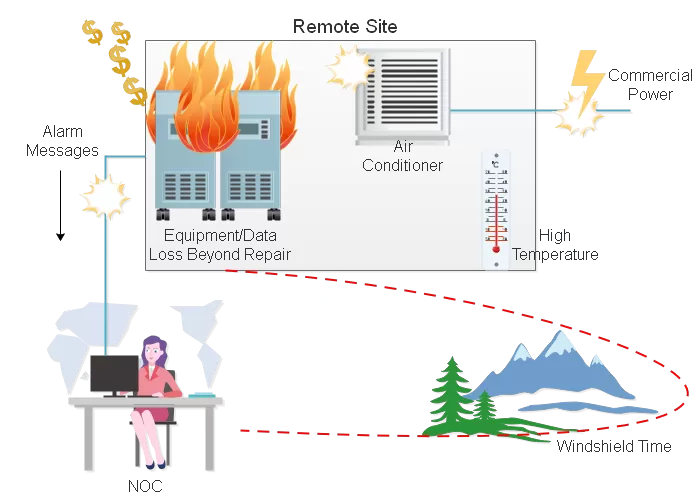Check out our White Paper Series!
A complete library of helpful advice and survival guides for every aspect of system monitoring and control.
1-800-693-0351
Have a specific question? Ask our team of expert engineers and get a specific answer!
Sign up for the next DPS Factory Training!

Whether you're new to our equipment or you've used it for years, DPS factory training is the best way to get more from your monitoring.
Reserve Your Seat TodayYou can forget the important role your operation plays - or all the people who depend on it. You can't afford to have your remote telecom sites go dark because of an unreliable power supply.
Imagine the things that can go wrong when you fail to provide reliable power:
For all of these reasons, you must have solid battery and rectifier monitoring. Without it, you're reacting to failures only after they've happened. This can leave you dealing with massive downtime, frustrated customers, and costly emergency site visits.
Unfortunately, not all monitoring solutions will do the job. You have to do your homework and make the right choice. Let's take a look at how to find the equipment for your battery and rectifier monitoring.

When a power failure hits one of your remote telecom sites, the clock starts ticking. Every minute of downtime means:
The worst part? Many power failures are completely preventable. Battery and rectifier issues rarely strike without any clues. They often show gradual warning signs - like slowly declining voltage or occasional temperature spikes.
With real-time monitoring for both your batteries and rectifiers, you catch these issues before they result in service outages. You move from frantically reacting to failures to proactively preventing them.
Some remote site operators rely on manual battery inspections or very basic rectifier alarms. While that might have worked in the past, it's simply not enough in telecom environments today.
Sending a technician out for periodic battery tests is expensive. It also leaves you blind between site visits. Small battery or rectifier issues can fester into full-scale failures before your next round of inspections.
Most rectifiers have built-in monitoring, but they typically only report major failures. By the time you see an alarm, you're already in trouble. Without real-time analytics, you have no chance to intervene before the outage occurs.
Battery and rectifier alarms are often scattered across multiple platforms - if you even have them at all. Trying to correlate that data, or make sense of it in a single view, is tough without a centralized monitoring solution.
Power failures rarely come out of nowhere. Watch out for these red flags:
Without the right tools in place, these subtle symptoms are easy to overlook. Then, before you know it, you're dealing with an expensive outage and an emergency site visit.
Skipping battery monitoring to "cut costs" typically backfires in spectacular ways:
By proactively tracking battery and rectifier health, you stretch out equipment life. You also reduce emergency expenses and dramatically lower your total number of network disruptions.
Telecom sites rely on multiple layers of power redundancy, but you're flying blind if you don't monitor them in real time. A good monitoring system goes beyond detecting failures - it actively prevents them by identifying issues early.
Now, imagine having a system that:
Instead of reacting to problems, you'll stop them from happening in the first place.
DPS Telecom is a manufacturer of mission-critical telecom monitoring gear. Our cohesive power monitoring solutions will help you guarantee dependable uptime for your operations.
By combining devices like the T/Mon SLIM master station with the BVM G3 (Battery Voltage Monitor), you can get a single unified view of all your power assets.
This centralized master station organizes alarm data from multiple RTUs or similar devices. The master device is able to:
This battery monitoring device is specifically designed for voltage monitoring in telecom buildings, data centers, and remote sites. It focuses on:
The BVM sensors that go with the BVM G3 are high-precision sensors that monitor both AC and DC voltages in real time. This allows you to detect power failures before they cause critical downtime. As a whole, the sensors:
With this combined setup, you'll eliminate guesswork and make data-driven decisions about power maintenance and replacements.
One of the biggest headaches in telecom monitoring is juggling multiple disconnected systems. Without a unified system:
With the T/Mon SLIM, you can unify them all in one place. You get a single-pane-of-glass view of:
This dramatically reduces response times and confusion. You'll know exactly what's happening at each site, at all times.
When monitoring mission-critical infrastructure, you can't afford to gamble on untested gear or fleeting "bargain" solutions.
DPS Telecom has been designing and manufacturing remote monitoring equipment for decades. Our gear has a history of providing:
You'll drastically reduce downtime, extend your battery life, and eliminate painful blind spots in your network.
No two telecom networks are exactly alike. That's why DPS offers flexible, scalable monitoring for your unique infrastructure. You might need:
For any and all of these, we can help you. Let's talk about your project so we can craft the correct "perfect fit" solution together.
Call: (559) 454-1600
Email: sales@dpstele.com

Andrew Erickson
Andrew Erickson is an Application Engineer at DPS Telecom, a manufacturer of semi-custom remote alarm monitoring systems based in Fresno, California. Andrew brings more than 18 years of experience building site monitoring solutions, developing intuitive user interfaces and documentation, and opt...